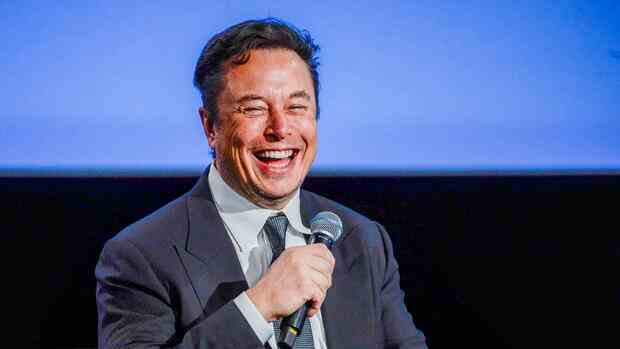san francisco Tesla boss Elon Musk has presented his plan for making the world independent of fossil fuels. “There is a clear path to a fully sustainable Earth,” Musk said at Wednesday’s investor day in Austin, Texas.
Musk said 240 terawatt hours of battery capacity was enough to meet that goal. This number includes both batteries for electric vehicles and stationary energy storage. That is about 480 times the capacity of the batteries that will be produced worldwide in 2022.
During the four-hour presentation, nearly 20 Tesla executives presented information about working at the electric car manufacturer. However, Musk and his team were reluctant to give details about the strategic direction. Investors had apparently expected more: Tesla shares fell by around five percent in after-hours trading.
Because when it came to the central question of whether and how the existing models would be revised, the announcements remained vague. Musk spoke several times of a “next-generation vehicle”. However, he did not give any further details.
The verdict from analysts was mixed. “The model range is showing its age,” said Christian Koenig. The car expert has worked for Porsche in North America and runs an electromobility consultancy in Atlanta. Musk and his team failed to present concrete plans for a revision here.
Next plant planned in Mexico
Tesla’s manufacturing boss Tom Zhu confirmed that the group will set up its next production facility in Mexico. After the plants in Shanghai and Grünheide, the next location outside the USA is to be set up in Monterrey. Zhu also announced that Tesla has produced a total of four million vehicles since the company was founded.
“It took us 12 years to build the first million and about 18 months for the second million. For the third million, it was eleven months. The fourth million took us less than seven months,” Zhu said, citing the company’s improved operational efficiency.
Zhu also tried to allay concerns about sales problems in China. “As long as you offer a quality product at an affordable price, you don’t have to worry about demand,” Zhu said. “We’re trying everything we can to reduce costs,” he added, “and pass that on to our customers.”
The quarterly figures in the last quarter fell short of the expectations of experts.
(Photo: dpa)
Musk said the group plans to have “maybe ten vehicle models” in the long term. These would be enough to reach the sales target of 20 million vehicles per year. Tesla currently has four models on offer. The introduction of new models had often been delayed in the past. The so-called “Cybertruck” is scheduled to go into production this year.
Tesla’s design boss Franz von Holzhausen spoke at length about improved vehicle production. However, he said the company would not comment on other models until “at a later date”.
From the shareholders’ point of view, new impetus is needed
It’s not the first time Musk has unveiled a “master plan.” Tesla presented its first master plan in 2006. It covered the construction of an entire family of electric cars, “including inexpensive family cars” and was ahead of its time: Tesla presented the first car, the Roadster, in 2008.
The second master plan followed ten years later, in 2016. In it, Musk outlined his plans to expand the model range and bring battery storage into the homes of users, in conjunction with solar panels on the roof. The most important topic, however, was automated driving. Musk said that within a few years, he wants to come up with a workable autopilot that will “allow your car to make money for you when you’re not using it.”
According to Musk, the associated robotaxi fleets should be “functionally available” by 2020 at the latest – a promise that prompted prominent investors such as Cathie Wood to buy Tesla shares. As of today, however, a rapid introduction is not to be expected. Tesla’s approach of only relying on cameras instead of additional radar and lidar sensors is viewed critically by US regulators, among others. The autopilot, which Tesla sells as a “Full Self-Driving Beta” for an additional price of $15,000, still makes numerous mistakes.
From a shareholder perspective, Tesla can use new impetus. The group earned more in 2022 than ever before in a fiscal year and increased profits by 128 percent to $ 12.6 billion (11.5 billion euros). According to the analysis company Factset, profit and sales in the final quarter (3.7 and 24.3 billion dollars) remained slightly below expectations. Tesla also missed its 50 percent growth target in 2020.
>> Read More: Battle for car software – Will VW, Mercedes and BMW capitulate to Google?
Wall Street is concerned that Tesla is hitting a ceiling after years of rapid growth. Recent price cuts had also fueled concerns that demand for Tesla cars could dwindle and the long-hyped company could become just one carmaker among many.
The current model generation is showing its age, and hopefuls like the Cybertruck pick-up have been a long time coming. It should not be delivered on a larger scale until 2024, as Musk had explained. Meanwhile, the competition is not sleeping: classic car manufacturers such as Ford and GM are celebrating delivery records with all-electric versions of their pick-up trucks, which are popular in the USA.
Tesla lost around $675 billion in market capitalization last year. The course had collapsed by 65 percent – a negative record. Since the turn of the year, the share has recovered significantly and has risen to $205. By the end of 2021, it was over $400.
More: How Microsoft and Google are using AI to transform the Internet
